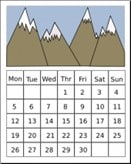Doubt and worry are always in the background, and those feelings can be triggered by a ringing phone, a twinge or ache somewhere in my body, or the verbal angst that my children sometimes express. It’s like a part of me relives the trauma. –JN
 Most of us live life in segments. We are taught that life has stages: infancy, childhood, adolescence, young adulthood, and beyond. Time is also experienced in segments. For many of us, our internal calendar year is set by the start and end of the school year, and even by the length of classes. When I was in high school and college, most of my classes were 50 minutes long. Even now, many years later, a 50-minute clock ticks inside me. Toward the end of a 50-minute time span, my attention starts to wane. Long ago, my brain learned that at the end of 50 minutes, it is time to move to a different activity.
Most of us live life in segments. We are taught that life has stages: infancy, childhood, adolescence, young adulthood, and beyond. Time is also experienced in segments. For many of us, our internal calendar year is set by the start and end of the school year, and even by the length of classes. When I was in high school and college, most of my classes were 50 minutes long. Even now, many years later, a 50-minute clock ticks inside me. Toward the end of a 50-minute time span, my attention starts to wane. Long ago, my brain learned that at the end of 50 minutes, it is time to move to a different activity.
Viewing life and time in chunks influences how we look at our health journeys. We think of health crises as falling into distinct stages: diagnosis, treatment, and beyond. But our emotions don’t follow such a predictable pathway. Emotions ebb, flow, and spike from a variety of triggers.  A trigger is something that sparks a memory of a previous experience. The trigger connects you to the past, making you feel like you are experiencing it all over again. The reemergence of emotions through triggers is part of what occurs once the main crisis is over.
A trigger is something that sparks a memory of a previous experience. The trigger connects you to the past, making you feel like you are experiencing it all over again. The reemergence of emotions through triggers is part of what occurs once the main crisis is over.
I think that every ache and pain is a side effect of something related to the cancer. It triggers me all over again.–SJ
Pain as a Trigger
 Every time I get a headache, I wonder if I have a reoccurrence of a brain tumor. –JZ
Every time I get a headache, I wonder if I have a reoccurrence of a brain tumor. –JZ
Some triggers are predictable, while others catch off us guard. One of the most predictable triggers is pain, because pain and emotions ignite overlapping parts of the brain. Therefore, when we feel pain, we feel a surge of emotions associated with that pain. Not only does one feel the physical pain, but also the emotional distress linked to the pain and trauma of what causes the pain.
I’ve been living with this chronic pain and life-altering diagnosis for over 40 years. Some times have been worse than others, yet I find I have meltdowns that come out of nowhere. –LE
Every time I have to have blood work done, I worry. I tend to wake up around 3:00 a.m.: the time THE call came in telling me to go to the hospital. –LL
Sensory Triggers
When I get behind the wheel of a car, I get anxious because of the accident. Being near a truck causes extreme stress because most of the material in truck beds is not tied down. I can still see the metal piece flying through the air and breaking my windshield, causing my multiple surgeries. –CK
 Our suburban yard backs up to the woods. It’s not unusual to see a family of deer roaming through our yard. These deer seem quite content as they munch their way through the garden I’ve painstakingly nurtured over the years. My presence doesn’t cause them to flee, but the shaking of a paper bag I wave like a crazy woman sends them leaping back to the depths of the forest. What is it about the sound of the bag? Why does that bother the deer, whereas standing in close range barely causes them to look up? Dr. Leonard Perry, an Extension Professor at the University of Vermont, wrote[1] that deer sense potential danger when unexpected motions or sounds occur. Unexpectedness is the key. My presence isn’t unexpected to these practically domesticated deer, but the sound of the paper bag is unique, causing them to flee. My paper bag is the deer’s mountain lion.
Our suburban yard backs up to the woods. It’s not unusual to see a family of deer roaming through our yard. These deer seem quite content as they munch their way through the garden I’ve painstakingly nurtured over the years. My presence doesn’t cause them to flee, but the shaking of a paper bag I wave like a crazy woman sends them leaping back to the depths of the forest. What is it about the sound of the bag? Why does that bother the deer, whereas standing in close range barely causes them to look up? Dr. Leonard Perry, an Extension Professor at the University of Vermont, wrote[1] that deer sense potential danger when unexpected motions or sounds occur. Unexpectedness is the key. My presence isn’t unexpected to these practically domesticated deer, but the sound of the paper bag is unique, causing them to flee. My paper bag is the deer’s mountain lion.
Touch, sound, sight, taste, and smell are our basic input sensory systems. When our sensory systems receive information, our brains take note. Our sensory sensitivities vary. One of my grandsons, Porter, covers his ears when the public bathroom hand dryer turns on. Another grandson, Rowan, was literally knocked down  by the burst of air emitted from the hand dryer and didn’t miss a beat. The loud noise of the dryer rankles Porter’s nervous system, creating his startle response, whereas Rowan’s system is unfazed. After a few exposures to the loud hand dryer, the mere sight of it causes Porter to cover his ears as his brain prepares him for the sensory overload. The links between what he sees (hand dryer), the sensory overload (noise), and his emotion (distress) have been cemented in his mind.
by the burst of air emitted from the hand dryer and didn’t miss a beat. The loud noise of the dryer rankles Porter’s nervous system, creating his startle response, whereas Rowan’s system is unfazed. After a few exposures to the loud hand dryer, the mere sight of it causes Porter to cover his ears as his brain prepares him for the sensory overload. The links between what he sees (hand dryer), the sensory overload (noise), and his emotion (distress) have been cemented in his mind.
As adults, we’ve learned to handle loud and annoying sounds, but when we undergo a novel situation, our brains become like a child’s (or a deer’s). We’re on alert. Our brains link sensory input with distress, and the mere exposure to the sensory stimulus later can precipitate a reaction. For example, some people hate the smell of hospitals. Is it the actual smell that is unpleasant, or is it the link that sits in our brain between the smell and the emotion we felt when we visited someone in the hospital, saw someone ill, or was a patient there? In these moments, we become like the deer. Sudden and unexpected sights, smells, and sounds trigger feelings related to medical journeys. Like the deer, we want to bolt.
 Not all triggers can be avoided, but there are some strategies to help ease sensory triggers. For example, breathing exercises can ease the reactions the trigger is igniting. Distracting yourself with a positive sensory experience (e.g., music, favorite food, movement) can spark the brain to shift gears. When identifying a positive sensory experience to take the place of a noxious one, stay in the same sensory category. If it is a smell, expose yourself to a positive smell. For example, if the smell of hospitals is a negative, engage your nose and taste buds with peppermint gum. For Porter and the hand dryer, I had him close his eyes so he couldn’t see it, and I sang to him so he has something else to listen to other than the blasting air of the dryer.
Not all triggers can be avoided, but there are some strategies to help ease sensory triggers. For example, breathing exercises can ease the reactions the trigger is igniting. Distracting yourself with a positive sensory experience (e.g., music, favorite food, movement) can spark the brain to shift gears. When identifying a positive sensory experience to take the place of a noxious one, stay in the same sensory category. If it is a smell, expose yourself to a positive smell. For example, if the smell of hospitals is a negative, engage your nose and taste buds with peppermint gum. For Porter and the hand dryer, I had him close his eyes so he couldn’t see it, and I sang to him so he has something else to listen to other than the blasting air of the dryer.
Below is an example of a chart to become aware of your own triggers and coping techniques. Go to:
Workbook Chapter 17 Triggers Sensory Triggers
|
I am triggered by these |
Plan/Techniques to help |
|
|
Smell
|
|
|
|
Smell
|
|
|
|
Sound |
|
|
|
Sound
|
|
|
|
Taste
|
|
|
|
Taste
|
|
|
|
Touch
|
|
|
|
Touch
|
|
|
|
Sight
|
|
|
|
Sight
|
|
|
I had to change doctors. After three miscarriages and two failed IVF treatments, I couldn’t go back to the medical office building without having a panic attack. Just seeing the building set off emotional reactions. –SS
Driving down the road, someone laid on their car horn. I jumped in my seat while swerving my car closer to the side of the road, only to learn the horn wasn’t for me. I am so jumpy when something unexpected happens. –CS
Anniversary Triggers
The anniversary of a diagnosis, accident, or death can be a predictable trigger. Flipping the calendar page and knowing that the “date” looms ahead sends emotions coursing through us. Sometimes we don’t even realize a certain turning point on the calendar is approaching, but our body and deeper memories know this was a critical time. A surge in emotions related to time is referred to as an “anniversary reaction.”
Anniversary reactions are an interplay between the brain and emotions. The brain stores the event in the memory in order to try to protect us from future pain and shock. Yet as we learn in life, we can’t always protect ourselves. People get sick, die, experience violence, and suffer. When the anniversary of those moments looms, the emotions related to the memories are sparked and the old feelings surge forth.
 The one advantage of anniversary reactions is that we know which dates might be challenging and can take action to cope. Suggestions to help lessen anniversary reactions include:
The one advantage of anniversary reactions is that we know which dates might be challenging and can take action to cope. Suggestions to help lessen anniversary reactions include:
Make specific plans for the day/time.
Some do better with recognizing the day with a ceremony or spending it with family/friends; others do better distracting themselves by traveling, being outdoors, or immersing themselves in an activity.
Some want the support of family and friends; others prefer to be by themselves during these anniversary times. Drawing within feels protective to them.
Workbook Chapter 17 Triggers Anniversary Triggers
What works best for you? Jot down some dates that may trigger you and what you can do to support yourself.
|
Date |
I plan to… |
|
|
|
|
|
|
|
|
|
|
|
|
|
|
|
[1] http://pss.uvm.edu/ppp/articles/deerdeter2.htm
Featured image courtesy of Jordan_Singh on Pixabay.

0 Comments